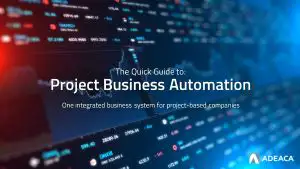The world has seen nothing quite like the impact of COVID-19. For most of 2020, project businesses have struggled to adapt to safety regulations put in place by local governments, attempting to undertake the largest and fastest workforce transformation ever.
According to an International Data Corporation (IDC) report, in the second quarter of 2020, cloud IT infrastructure investments increased by 35 percent year on year. Of course, this a direct result of the major adjustments businesses had to make as a result of the pandemic. Industries across the board saw a massive shift to online tools and solutions that enabled collaboration and virtual meetings. IDC believes “the hardware infrastructure market has reached the tipping potin and cloud environments will continue to account for an increasingly higher share of overall spending.”
For Project Businesses, many are on the same path to embracing new technologies not only to survive but move forward and succeed in the future. The new normal demands a major digital transformation for project businesses.
“If changes are too small, organizations run the risk of digitizing the past instead of innovating and transforming the future,” said Carsten Lin, Group Digital Officer BASF, in a World Economic Forum article. “To not let the crisis go to waste, we need to challenge our basic assumptions about how to create, deliver and capture value.”
Time to Reinvest with Project Business Automation
This is an opportunity for project businesses to do away with their fragmented application landscape and operate in an environment that enables effective collaboration and real-time data integration so everyone can work from one source of truth.
Project Business Automation does just that. It rejects the status quo of disconnected applications in favor of one integrated business system- one that includes support for all project business processes and connects them seamlessly in real time.
PBA’s core elements include:
Project Financials
While traditional accounting tools work fine for industries such as retail and manufacturing; project-based companies require much more than what most project accounting systems offer. PBA closes the gap between what project businesses need and what mainstream ERP solutions offer.
To track actual costs and invoices, revenue recognition, accruals and budgets, a solid accounting framework is necessary. However, when it comes to securing project profitability and supporting effective decision making, it’s much more important to be able to project and track EAC, variances, profitability, contingencies and productivity while identifying trends and maintaining a full audit trail.
Project Management
When your bread and butter is dependent on the successful delivery of projects to your customers, there’s no room for error. The lack of real-time insight into your operations will result in increased risk and decreased profitability. This can ultimately impact your reputation and relationships with customers.
Historically, project management applications were built to manage standalone projects. The fact is, they’re not meant to run an entire project business.
PBA offers a unique approach to managing project operations by providing complete and real-time integration between back-end ERP functions and your operational project management activities. This means the project plan is the central entity against which a host of other operational activities are planned and managed.
PBA enables companies to control process flows throughout the entire enterprise by establishing an enforceable and repeatable business model.
Project Insight
It’s one thing to manage project financials and operations, but when it comes to projects, it’s more than what you know, it’s when you know it that counts. PBA gives executives and managers the real-time insight they need to not only make important business decisions, but also transform their companies into high-performing enterprises. PBA gets the right information to the right people instantly.
Successful project businesses understand that to do a better job of communicating, everyone needs to be on the same page. It’s about giving everyone the tools and having them work from one source of truth. Effective communication and collaboration between stakeholders ensure better outcomes for your projects.
PBA is the Only Way to Deliver More Projects On Time and On Budget
Projects are risky business. There’s a lot of moving parts and a lot of hands on deck. The only way to successfully deliver projects is to adopt a holistic, all-in-one project-based solution that gives you total control over your business and allows you to manage your projects proactively. If you don’t know there’s a potential problem and it eventually becomes a major risk to the project, you’re doing things all wrong. Project Business Automation is the only solution on the market that stands to eliminate other project applications and increase massive efficiencies.
Download the Project Business Automation Requirements Template to learn more about everything that a comprehensive system should cover for your business.











